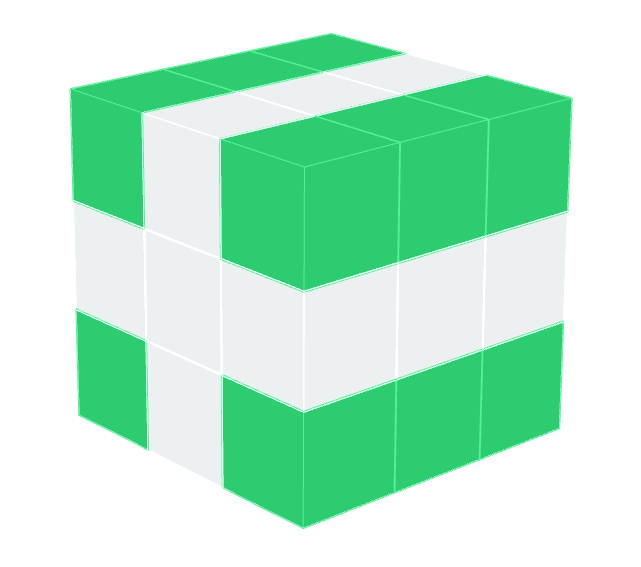3d-adjacency 中文文档教程
3d-adjacency
从 3d 数组中查找相邻单元格的“集群”。 该阵列不需要必须是立方体,但它确实需要是直角棱柱。
example
假设你有一个三维数组,里面全是 0 和 1。 0 是白色,1 是绿色。 ,它可能看起来像:
从图形上看
你想要的是一组相连的绿色单元格。 它可能看起来像:
从图形上看
, 这正是这个模块提供的! 雅虎!
const adj3d = require('3d-adjacency')
const exampleCube = [ // as shown above
[
[1, 0, 1], [0, 0, 0], [1, 0, 1],
],
[
[1, 0, 1], [0, 0, 0], [1, 0, 1],
],
[
[1, 0, 1], [0, 0, 0], [1, 0, 2],
],
]
const groups = adj3d.find(exampleCube)
// ==>
/*
[ // four groups of green blocks
[
{ x: 0, y: 0, z: 0, value: 1 },
{ x: 1, y: 0, z: 0, value: 1 },
{ x: 2, y: 0, z: 0, value: 1 }
],
[
{ x: 0, y: 0, z: 2, value: 1 },
{ x: 1, y: 0, z: 2, value: 1 },
{ x: 2, y: 0, z: 2, value: 1 }
],
[
{ x: 0, y: 2, z: 0, value: 1 },
{ x: 1, y: 2, z: 0, value: 1 },
{ x: 2, y: 2, z: 0, value: 1 }
],
[
{ x: 0, y: 2, z: 2, value: 1 },
{ x: 1, y: 2, z: 2, value: 1 },
{ x: 2, y: 2, z: 2, value: 2 }
]
]
*/
“嘿,为什么输出与输入不匹配相同的形式?”
有效的问题。 具体来说,输出是一组坐标+值的对象。 输入是实际数据。 尽管人们可能希望输出类似于 [ [0, 1, 2] ],其中 0, 1, 2 是坐标,但输入不是坐标集首先。
install
npm install --save 3d-adjacency
usage
请参阅上面的示例和官方 API 文档
changelog
- 0.0.3 handle much larger arrays. remove recursive calls to keep stack down
3d-adjacency
find "clusters" of adjacent cells from a 3d array. the array does not need to be cubic, but it does need to be a rectangular prism.
example
suppose you had a three dimensional array, full of 0s and 1s. 0s are white, and 1s are green. graphically, it may look like:

what you desire is the sets of connected green cells. graphically, it may look like:

well, that's exactly what this module provides! yahoo!
const adj3d = require('3d-adjacency')
const exampleCube = [ // as shown above
[
[1, 0, 1], [0, 0, 0], [1, 0, 1],
],
[
[1, 0, 1], [0, 0, 0], [1, 0, 1],
],
[
[1, 0, 1], [0, 0, 0], [1, 0, 2],
],
]
const groups = adj3d.find(exampleCube)
// ==>
/*
[ // four groups of green blocks
[
{ x: 0, y: 0, z: 0, value: 1 },
{ x: 1, y: 0, z: 0, value: 1 },
{ x: 2, y: 0, z: 0, value: 1 }
],
[
{ x: 0, y: 0, z: 2, value: 1 },
{ x: 1, y: 0, z: 2, value: 1 },
{ x: 2, y: 0, z: 2, value: 1 }
],
[
{ x: 0, y: 2, z: 0, value: 1 },
{ x: 1, y: 2, z: 0, value: 1 },
{ x: 2, y: 2, z: 0, value: 1 }
],
[
{ x: 0, y: 2, z: 2, value: 1 },
{ x: 1, y: 2, z: 2, value: 1 },
{ x: 2, y: 2, z: 2, value: 2 }
]
]
*/
"Hey, why is output not matching the same form as the input?"
Valid question. Specifically, the output is a set of objects that are coordinates+values. the input is the actual data. Although one might expect the output to be something like [ [0, 1, 2] ], where 0, 1, 2 are coordinates, the input was not coordinate sets to begin with.
install
npm install --save 3d-adjacency
usage
See example above and the offcial API docs
changelog
- 0.0.3 handle much larger arrays. remove recursive calls to keep stack down


